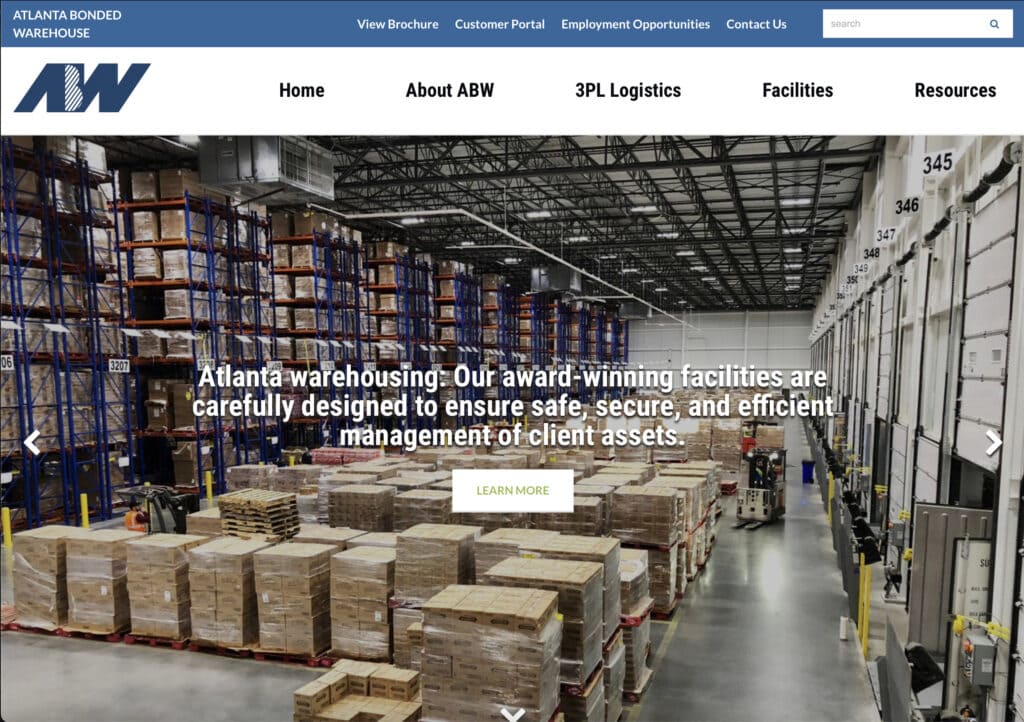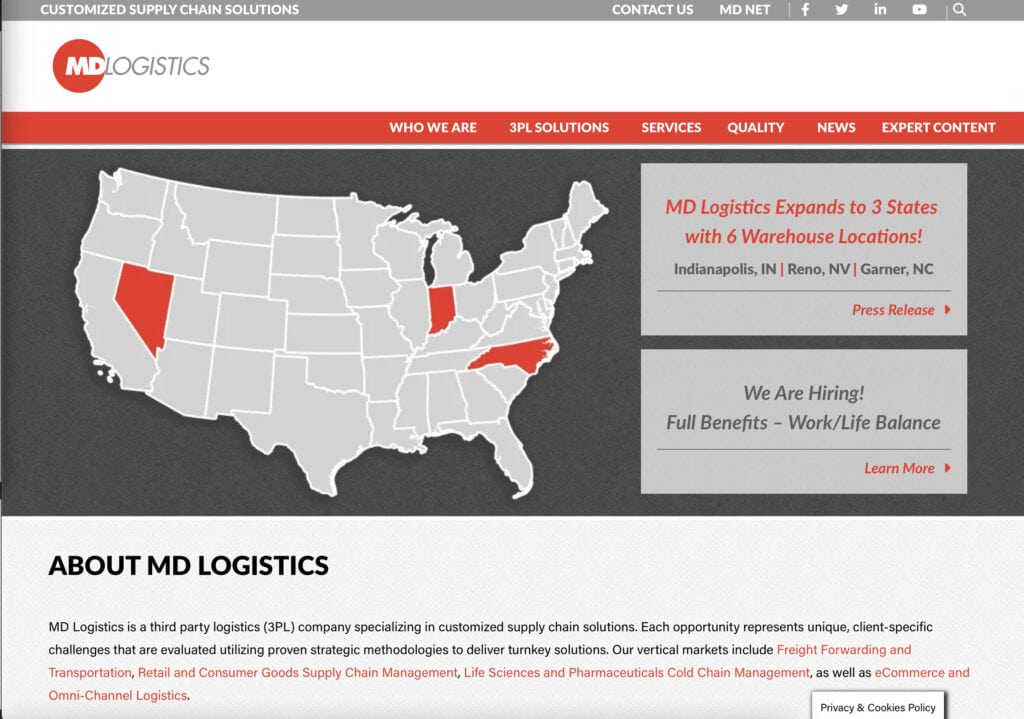Web Cite City
Warehousing

Aero Fulfillment Services
Since 1986, Aero has been the right choice for Fortune 1000 through established ecommerce businesses to make their fulfillment more effective, more efficient, and easier to manage. Our Midwest location allows our clients to centralize their inventory; eliminating the complexities and additional costs typical of a multi-facility set up. And our unique arrangements with our shipping partners allow us to provide 3 day ship (or less) to the lower 48 states—at ground rates.

Atlanta Bonded Warehouse
Atlanta Bonded Warehouse (ABW) has been providing public and contract food grade, temperature controlled distribution services for over 75 years. ABW is a leader in providing integrated asset-based logistics solutions for the food, pharmaceutical, household durables, and CPG industries. Our goal is total customer satisfaction through continuous innovation in technology and in best practices by focusing on teamwork, integrity, and accountability, all in a safe working environment.

Brook Warehousing Systems
Brook Warehousing Systems specializes in handling package chemicals, pharmaceuticals, food grade products, U.S. Customs bonded warehousing, importing/exporting, and general commodities. We are supported by a superior customer service staff and excellently positioned on the East Coast. We own and/or operate more than 500,000 square feet, with facilities in Bridgewater, Somerset, and Linden, N.J. Please visit our Web site today!

Cargo Zone, LLC
Cargo Zone LLC is under final review and confirmation as a General Purpose Foreign Trade Zone in Nebraska. Its 250,000 square feet, 17-acre site, and heavy lift equipment allows for answers to every warehouse concern. Our link to Target Logistic Services offers global supply chain solutions.

D&M Distribution Services, Inc.
Our firm is an Oklahoma-based public warehouse, which is headquartered in Oklahoma City, Okla., with more than 500,000 square feet of space. We also have a facility in Ponca City, Okla. D&M Distribution is served by both of the major western U.S. railroads — UP and BNSF — through Stillwater Central. Established in 1990, we are a Certified Native American Minority Enterprise.

D+D Distribution Services
D&D is a full-service public warehousing and distribution services provider. We are located in York, PA placing us near the mid-Atlantic region’s major metropolitan areas and seaports. We serve customers around the globe, developing customized logistics and customer service solutions. We handle raw materials at the front end of the supply chain and finished goods at the back end. D&D develops flexible programs to accomplish customers’ goals.

Dart Advantage Warehousing, Inc.
Dart Advantage Warehousing, Inc. (DAW) is a Minnesota-based company providing flexible, real-time inventory controls and tailored warehousing solutions. DAW operates nationally, including six owned facilities in Minnesota, Pennsylvania, and Georgia, encompassing more than one million square feet of food grade and non-food grade space. Call us today to find out how Dart Advantage Warehousing, Inc. can become your full-service logistics and supply chain solutions expert! 800-682-9980 ext 1849.

DDC Dependable Distribution
The Dependable family of transportation services is comprised of six main business groups, serving nearly all areas of the logistics industry. Each of the six divisions — DHE, DDC, DLS, DHX, DGX, and DAX — have achieved double-digit growth over the past five years, while earning a reputation for leadership in their respective fields.

Distribution Inc.
http://www.distributioninc.biz
Located in Lincoln, Neb., Distribution Inc. is a 120,000-plus-square-foot warehouse that supplies value-added services to companies that realize the cost-saving advantages of outsourcing their warehouse needs. With its 24/7 warehouse services, and fleet of late-model power units and trailers to handle your cartage, Distribution Inc. is your logistics and warehousing partner.

Ferber Warehousing
Ferber Warehousing is a full-service storage, cross-docking, distribution, and fulfillment facility for the automotive, e-commerce, commercial, retail, electronic and industrial product markets. We have 500,000 square feet of floor space required for bulk container processing and palletizing; inspecting, testing and processing returns, shipment consolidations, repackaging and kitting multiple item shipments. Inspected and approved by the State of Michigan’s Liquor Control Commission, GSA, and General Motors Corporation.

FW Logistics
When you select FW Logistics to manage your logistics processes, you get a knowledgeable partner and a recognized leader in logistics planning services within the warehousing industry. Because FW Logistics is one of the most innovative and progressive transportation companies, we provide a unique and advanced approach to the storage and transportation of your goods. Our years of experience makes us the leader in the industry, and we continue to grow by helping companies understand how planning their logistics strategy will build their business.

Holman Logistics
As an Inbound Logistics Top 100 3PL, Holman Logistics offers both multi-client and dedicated warehousing and distribution services across the United States. Holman is an expert plant support service provider to CPG and durable goods manufacturers, working collaboratively with customers to facilitate production inside manufacturer-owned plants, mills, and facilities at all levels of the manufacturing process. Holman Logistics also offers a broad array of transportation services including truckload, LTL, expedited same-day delivery, sorting, and shuttle services. Holman is proud to be celebrating 160 years of Extraordinary Service in 2024.

Hub Group
Hub’s extensive service network—built over many years—enables it to provide innovative transportation solutions that are versatile, flexible, and designed to deliver maximum efficiency. With this advantage, Hub Group is able to collaborate with customers daily to help them meet their transportation challenges. With intermodal, highway, and logistics transportation offerings, the Hub Network is your single-source provider—coast to coast, border to border. Visit the website to learn what Hub can do for you.

International Warehouse Logistics Association
The International Warehouse Logistics Association’s web site provides a wealth of information about the outsourced logistics industry. As part of the site’s "Logistics Service Locator," viewers may search for third- and fourth-party logistics providers by geographic region or service specialty. In addition, the site provides information on Association membership, calendar listings of upcoming training courses and events, up-to-date industry statistics, and much more. Find what you’ve been looking for at www.iwla.com.

JIT Warehousing and Logistics
With more than 25 years of experience with imports and exports, JIT warehousing & Logistics offers warehousing, trucking, shipside delivery/pickup, drayage, and transloading. JIT operates 5 facilities and a heavy lift yard located in Savannah, GA within 3.5 miles of GPA terminals. Our project cargo division has specialized trucks and trailers, onsite crane services and is an approved vendor to work onsite the terminal. We are proud to announce our newest rail served facility opening summer 2023!

Kelley Entrematic
The Kelley brand was established in 1953 with the invention of the world’s first counterbalanced dock leveler. Today the Kelley product line includes dock levelers, vehicle restraints, integrated control systems, dock seals and shelters, HVLS warehouse fans, ergonomic scissor lift tables and a full array of products and services specifically designed to support your sustainability initiatives.

Koch Logistics
As an asset-based third-party logistics company, Koch Logistics has all the expertise, technology and resources needed to provide customized programs to our customers, and the management skills to execute these programs. We use a combination of both owned and contracted assets to deliver an optimal transportation logistics solution to you.

Lynden
Over land, on the water, in the air—or in any combination—Lynden has been helping customers solve transportation problems for almost a century. Operating in such challenging areas as Alaska, Western Canada, and Russia, as well as other areas around the globe, Lynden has built a reputation of superior service to diverse industries.

MD Logistics
MD Logistics is a third-party logistics (3PL) company specializing in customized supply chain solutions. Our vertical markets include life sciences and pharmaceuticals, retail and consumer goods, as well as transportation services. In addition to cold chain storage and foreign trade zone warehousing, our services range from packaging, omnichannel fulfillment and distribution, to global supply chain solutions, freight forwarding and freight management.

Metro Park Warehouse
Metro Park Warehouses is a full-service 3PL offering 2 million square feet in Kansas City of modern food-grade warehousing space, including air-conditioned & medical temperature-controlled space with licensed beverage & med/vet/pharma distribution, AIB Superior rating, and 5 rail facilities, all open to reciprocal switching. We also provide in-house local & regional trucking transportation and value-added services such as retail store displays, kitting, labeling and light assembly. Contact Metro Park to gain the competitive edge.
